Coordinated Water Efforts
We’re working with partners from around the Bay Area to study, protect, and preserve our water resources and address water-related issues facing our communities. Learn more about our coordinated efforts below:
FLOODS, DROUGHT, RISING SEAS, OH MY!
SUMMIT, 3/30/2018

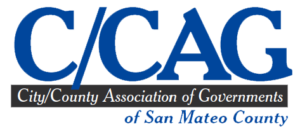
San Mateo County and the City/County Association of Governments (C/CAG) hosted an event on March 30, 2018 at Cañada College addressing water management issues in San Mateo County. The presentations, poster summaries, final remarks, speaker bios, and event photos are available here.
FLOODING AND DROUGHTS
FLOOD RESILIENCE PROGRAM
On February 23, 2016, the County of San Mateo Board of Supervisors approved $6.2 million over three years to begin to address flooding impacts in areas with cross-jurisdictional challenges. This launched the Flood Resilience Program, a team of two fully dedicated staff to hire consultants to design and implement flood resilience projects, seek grant funding, and collaborate with interested cities and relevant County resources. Since its inception, the Program has partnered with seven jurisdictions and multiple County initiatives to build a repeatable and sustainable process for prioritizing and implementing flood resilient projects.
Under the Program’s leadership, these “Collaboratives” can leverage local agency relationships, share decision-making responsibilities, enable potential funding partnerships, and apply for grant funding for the ultimate goal of improved project development. The Program’s current projects include: Bayfront Canal and Atherton Channel Flood Management and Habitat Restoration, Belmont Creek Flood Management Plan, Navigable Slough Feasibility Study, and the County-wide Flood Monitoring and Emergency Response Project.
Learn about the Flood Resilience Program here
TURNING ON THE TAP
WATER SERVICE AREAS
The County has two water service areas that provide residents and businesses with adequate and reliable supplies of high quality water to meet present and future needs in an environmentally and economically responsible manner. The County provides potable water to customers in the La Honda community, at Camp Glenwood Boys Ranch, at Sam McDonald Park, and in the Pescadero community.
Find more information about Water Service Areas here
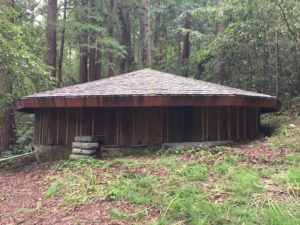 SMALL WATER SYSTEMS
SMALL WATER SYSTEMS
San Mateo County Environmental Health Services regulates smaller systems under the State Small Water Systems Program. A State Small Water System is a water system that serves water to 5 to 14 service connections and fewer than 25 people daily for at least 60 days out of a year. These systems are usually found in rural areas. Program staff ensure that State Small Water Systems provide safe drinking water in adequate supply, and under adequate pressure to the population served.
Find more information about County Water Service Areas here
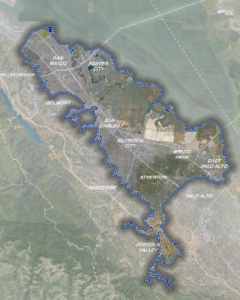 SAN MATEO PLAIN GROUNDWATER ASSESSMENT
SAN MATEO PLAIN GROUNDWATER ASSESSMENT
The San Mateo County Sustainability Department and Environmental Health Services are jointly working on a groundwater basin assessment of the San Mateo Plain Subbasin to assess the groundwater resources and current condition of the subbasin and identify potential groundwater management strategies. The project is funded by Measure A, a countywide half-cent general sales tax passed by voters in 2013, and the Sustainability Department. Work on the assessment commenced in April 2016; the assessment is scheduled to be completed by June 2018. The development of the groundwater basin assessment is a collaborative process that will result in a detailed understanding of the subbasin and modeling of future conditions. The Sustainability Department and Environmental Health Services are holding a series of workshops to solicit public and stakeholder feedback.
Find more information on San Mateo Plain Groundwater Assessment here
WESTSIDE GROUNDWATER BASIN
The Westside groundwater basin extends from the Bayside of San Mateo County in Burlingame to the Ocean-side of San Francisco City/County. San Mateo County initially facilitated the aggregation of data related to groundwater level measurements among the various well owners within San Mateo County. This effort eventually grew to a partnership that developed a voluntary groundwater management plan for the southern (San Mateo County) portion of the basin. The July 2012 South West Side Basin Groundwater Management Plan established a Groundwater Task Force to voluntarily guide the implementation of the Plan, share information, and interact in public on groundwater issues in the portion of groundwater basin within San Mateo County. San Mateo County is a stakeholder in this basin and a member of this task force.
KEEPING OUR WATER CLEAN
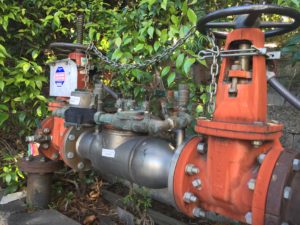
PUBLIC WATER DISTRIBUTION PROTECTION
The Cross Connection Control Program protects the public drinking water supply in most of San Mateo County. Inspection staff conduct surveys and/or inspections at facilities that may pose a threat to public health and safety. To eliminate the cross connection between the facility water supply and the public water supply, or threat to public health, the installation of a backflow prevention assembly on the facility water supply line from the public water system may be required in order to abate the public health hazard.
Learn more about the Public Water Distribution Protection Program here
LAND USE PROGRAM
All homes must have a safe water supply and a system for proper disposal of sewage and wastewater. More than 6500 households and businesses in San Mateo County are in areas that do not have a community water supply or a municipal sewer system. Structures in these areas are served by their own water and wastewater systems. The goal of the Land Use Program is to help people who live in these areas with these water supplies serving from 1 to 4 service connections from a common water source and/or onsite wastewater treatment systems (OWTS). Inspection staff also certify OWTS installers and soil percolation testers involved in the design of OWTS.
Learn more about the Land Use Program here.
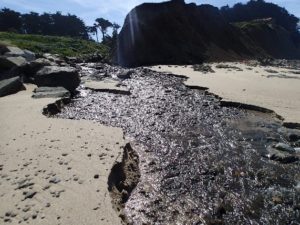 COASTAL CREEKS
COASTAL CREEKS
The County has watershed protection plans in two areas on the coast:
- San Vicente Creek watershed: In 2017, the County developed plans to prevent or reduce discharges of bacteria in the San Vicente Creek watershed due to findings of high levels of bacteria pollution. The County compiled five-year plans to implement strategies to target pollution from stormwater runoff and pet waste. Strategies range from increased maintenance, administrative controls, and outreach and education. The County is also monitoring water quality to gain a better understanding of sources of bacteria.
- Pacifica State Beach and San Pedro Creek watershed: In 2013 the San Francisco Regional Water Quality Control Board found that waters in Pacifica State Beach and San Pedro Creek had high levels of bacteria pollution. The County and the City of Pacifica worked together to develop a plan to monitor and reduce water pollution levels. The County is currently working with horse and dog facilities to implement practices that reduce bacteria pollution.
Learn more about our local watersheds here
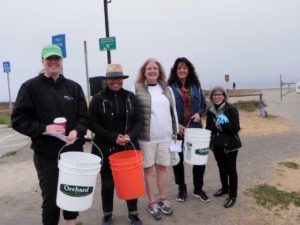 COASTAL CLEANUP DAY
COASTAL CLEANUP DAY
Coastal Cleanup Day is an annual waterway and land volunteer cleanup held on the third Saturday of September. Tens of thousands of people across the state come together to help make our communities cleaner and healthier for people and animals. Cleanups are held all over San Mateo County at beaches, creeks, waterways, parks and neighborhoods. Families are encouraged to bring their children, as this family-friendly event is a great opportunity to learn about litter and how to prevent it from ending up in our local streets and waterways. In 2016, over 4,000 residents came together and picked up over 26,000 pounds of trash and recyclables at over 50 locations in the County.
Learn more about Coastal Cleanup Day here
JAMES V. FITZGERALD AREA OF SPECIAL BIOLOGICAL SIGNIFICANCE
James V. Fitzgerald Area of Special Biological Significance is located on the coast a few miles north of Half Moon Bay and is home to hundreds of species of animals and plants. The Fitzgerald Marine Reserve, located within the ASBS, has been protected since 1969 because of its diverse aquatic species and habitats. From 2011 to 2016, the County implemented a program to protect water quality in the Fitzgerald ASBS. The work included water quality studies, education and outreach, and special stormwater practices to reduce water pollution.
Learn more about the James V. Fitzgerald Area of Special Biological Significance here
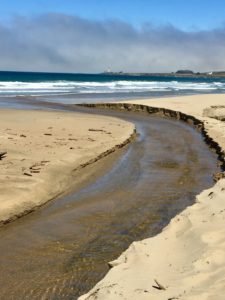 BEACH MONITORING
BEACH MONITORING
Thousands of people use San Mateo County swimming areas annually. On any one day people can be found swimming, surfing, body-surfing, diving, or just wading in the water’s edge at any of the ocean or Bay beaches in San Mateo County. Generally these waters are clean and safe for swimming. However, to ensure the public’s health is protected, San Mateo County Environmental Health Services and volunteer samplers test these waters weekly for unsafe concentrations of indicator bacteria. If problems are found the public is notified by signs at the beach, postings on the San Mateo County beach monitoring website and notification on the San Mateo County’s Beach/Creek posting hotline to warn the public that they may become ill if they come into contact with water in the posted areas.
Learn more about San Mateo County beach monitoring here
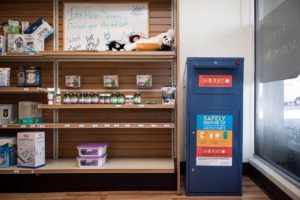 MEDICINE DISPOSAL
MEDICINE DISPOSAL
Disposing of unused and unwanted medicines by flushing them down the toilet can create problems downstream since water treatment plants are not designed to filter chemical compounds. To help protect the environment from medicine polluting waterways, the San Mateo County Board of Supervisors passed the Safe Medicine Disposal Ordinance in May 2015. The Ordinance requires medicine producers that sell their products in San Mateo County to provide all residents with a safe and convenient way to dispose of unwanted home-generated medicine. As of September 2017, there are 35 safe medicine disposal drop-off locations in the County.
Find your nearest safe medicine disposal location here
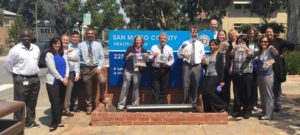 CIGARETTE BUTTS
CIGARETTE BUTTS
San Mateo County Environmental Health Services (EHS) is actively reducing cigarette butt litter throughout the County by partnering with local non-profits, businesses, city leaders, and residents. EHS recruits businesses to become a certified “Butt Free Business” by hosting receptacles outside storefronts to divert this type of pollution from entering storm drains.
The goal of these efforts is to reduce cigarette butt littering in San Mateo County by giving people the tools they need to prevent littering, dispel the myth that cigarette butts are not litter, and provide people with opportunities to clean up already littered butts. EHS is continuously working to expand receptacle installations and education efforts.
Learn more about the cigarette butt litter reduction program here

